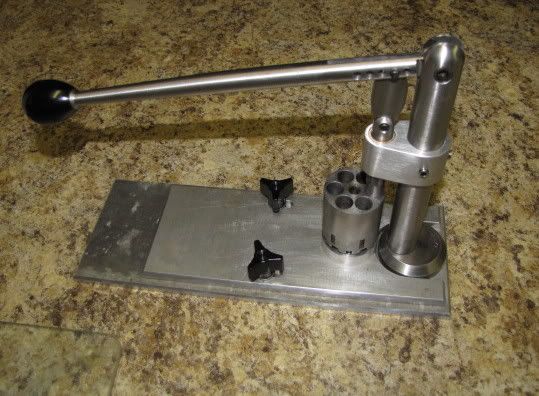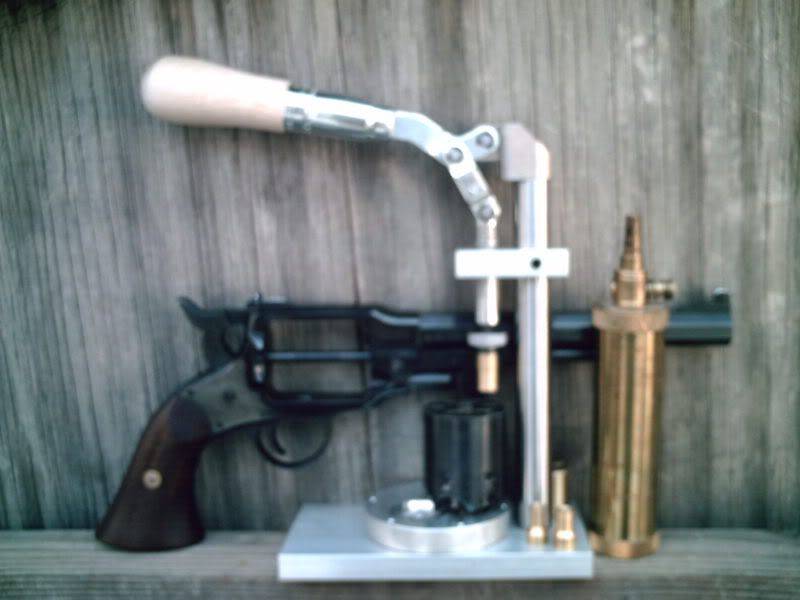On other pictures of presses ( not on this thread however) a tray is sometimes mounted on the base of the press. Is the convenient tray a necessity? Or just that--"convenient".I can see how a tray of some sorts would be a big help in loading.
You are using an out of date browser. It may not display this or other websites correctly.
You should upgrade or use an alternative browser.
You should upgrade or use an alternative browser.
Any DIY Cylinder Loaders?
- Thread starter nkbj
- Start date

Help Support Muzzleloading Forum:
This site may earn a commission from merchant affiliate
links, including eBay, Amazon, and others.
I load my pistol's just like Wild Bill Hickok did, one chamber at a time.
And thats a real good way to unload them-- one chamber at a time.I load my pistol's just like Wild Bill Hickok did, one chamber at a time.
arcticap
54 Cal.
Is it OK to make the ramrod part of these loaders from steel or should it be a "non-sparking" metal like brass?
I wouldn't want a rammer made of steel and prefer brass, but the rammer on the guns are made of steel.
The only factory rammers I've seen that is brass are the push rammers for the snubbie revolvers.

Here's the loading tool for the NAA .22 C&B revolver:

Here's some more loading presses:




Last edited:
Steel would be fine though brass would be less likely to ding the mouth of a chamber by accident.
If you're really worried about steel dinging up the chamber mouths put a piece of brass over the head of the rammer. I used a empty shell from a .38 on mine.
I especially like the wooden ones titled "zippy13" back in post#25. If I didnt already have a press I'd probably be out in the shop making one out of wood. Oak? I'm not saying they look fragile but even with the short handles they appear that I could apply too much leverage and break them. Are they fairly "sturdy"?
arcticap
54 Cal.
I especially like the wooden ones titled "zippy13" back in post#25. If I didnt already have a press I'd probably be out in the shop making one out of wood. Oak? I'm not saying they look fragile but even with the short handles they appear that I could apply too much leverage and break them. Are they fairly "sturdy"?
Yes, it worked fine and Zippy13 even offered to send people his design spec's..
He said: "I set out to design something could build with my limited capabilities. From red oak, with a 6-to-1 ratio and a 2-inch stroke,"
He was consulting with the person who made the one below using CNC, which he knew had an 8 inch lever.
Zippy13 knew that he could make his lever longer if needed.
But decided that it worked fine after range-testing it.
He said " It worked fine -- the leverage seems spot on. "

I think that Zippy13 may have also seen this one below which gave him the idea to use a toggle link in his design.
It was named the Triple P loader, designed by a person who then sold a limited number of them to members of some forums and maybe a few on eBay.
Perhaps 20 - 30 units more or less were made in total.
I was fortunate to pre-order one of these which also included a separate wad cutting die.
All custom made and assembled by an individual after testing and tweaking it in his spare time.
The toggle link and handle can be purchased online.
But it started out as a single home made loading press just like many limited production presses.

Last edited:
If I'm reading your post correctly that last press came with a wad cutting die? How did that work out?
arcticap
54 Cal.
The cutter was a custom accessory that was a special order.
I've only used it for cutting wax board cards from juice containers.
But it works well and cuts clean.
The press has a rubber cutting pad under the rotating cylinder plate in its base.
I place them over the powder, and then ram to heavily compress the 3F American Pioneer Powder to increase velocity.
They can be placed over the ball too, but not needed.








Shooting 32 grain loads of APP 3F.
I've only used it for cutting wax board cards from juice containers.
But it works well and cuts clean.
The press has a rubber cutting pad under the rotating cylinder plate in its base.
I place them over the powder, and then ram to heavily compress the 3F American Pioneer Powder to increase velocity.
They can be placed over the ball too, but not needed.








Shooting 32 grain loads of APP 3F.
Last edited:
Beautiful video. Does that wad cutter handle felt also?
arcticap
54 Cal.
Yes, I believe so.
Last edited:
Do you use felt wads in conjunction with the cardboard ones? Or how do you do that? One or the other or instead of or with? Curious on this end.
arcticap
54 Cal.
I don't use felt wads with the cards and APP doesn't recommend using lube.
I simply swab the barrel once in a while with mineral oil.
If someone wanted to use lubed wads, they could be placed over the cards to keep the lube away from the powder.
Filler can be used instead of a wad, or more than one card, to raise the ball closer to the mouth of the chamber.
I haven't experimented with wads because there doesn't seem to be any need to.
Vegetable fiber wads are an alternative to cards and cost about 2 cents each.
APP powder residue does seem easier to manage than other powder residues.
I simply swab the barrel once in a while with mineral oil.
If someone wanted to use lubed wads, they could be placed over the cards to keep the lube away from the powder.
Filler can be used instead of a wad, or more than one card, to raise the ball closer to the mouth of the chamber.
I haven't experimented with wads because there doesn't seem to be any need to.
Vegetable fiber wads are an alternative to cards and cost about 2 cents each.
APP powder residue does seem easier to manage than other powder residues.
That picture a few posts back of the cylinder face with the cardboard wads. What type of gun is that cylinder off of? The center hole that the cylinder pin goes through seems to be somwhat smaller than the others. I have an ASM in 44 cal. and all 7 holes seem to be roughly the same size.
The arbor hole in the cylinder varies with the model and the brand. I.e. different brands of '51 Navies may have different arbor sizes and within a brand the size may change over the years.
arcticap
54 Cal.
That picture a few posts back of the cylinder face with the cardboard wads. What type of gun is that cylinder off of? The center hole that the cylinder pin goes through seems to be somwhat smaller than the others. I have an ASM in 44 cal. and all 7 holes seem to be roughly the same size.
Those are .44 caliber Pietta Remington 1858 cylinders.
sgtprovo
45 Cal.
The best part about reloading cylinders is the invention of black powder pellets by Pyrodex and Hodgdon Triple 7,
no fuss, no mess, and every charge is molded to fit your cylinder.
no fuss, no mess, and every charge is molded to fit your cylinder.
Enfieldguy
32 Cal.
- Joined
- Oct 4, 2018
- Messages
- 81
- Reaction score
- 26
The best part about reloading cylinders is the invention of black powder pellets by Pyrodex and Hodgdon Triple 7,
no fuss, no mess, and every charge is molded to fit your cylinder.
LOL!! Not technically 'black powder'. Combustible paper cartridges have been around since about the 1850's accomplishing the same thing, (when correctly made).
Similar threads
- Replies
- 16
- Views
- 1K
- Replies
- 4
- Views
- 405



